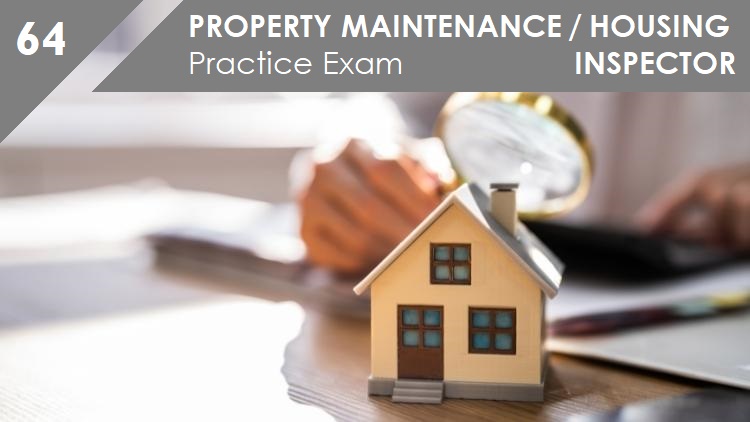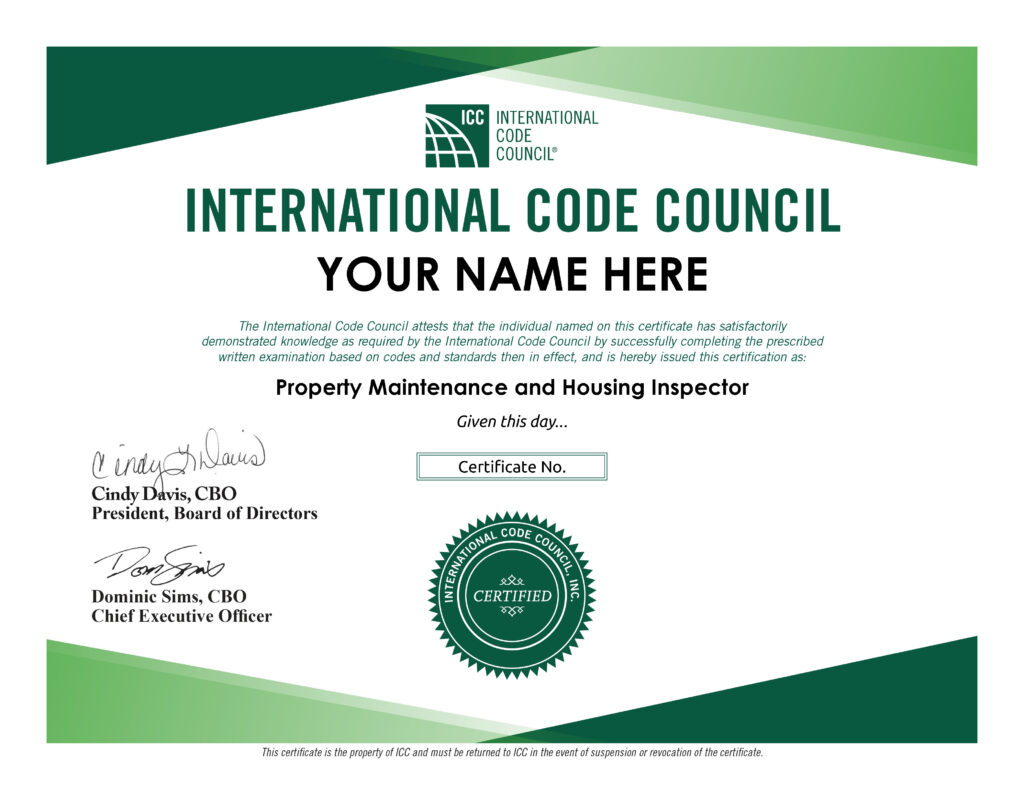
Includes 2 Practice Exams
50 Questions Each
Want to become a Certified Property Maintenance/ Housing Inspector?
The ICC Property Maintenance/ Housing Inspector Certification Exam administered by the International Code Council (ICC) tests an individuals knowledge of the International Property Maintenance Code® (IPMC®) and International Residential Code (IRC®).
Your first step is to know a little bit about the exam itself and what areas you should be studying for.
As a Certified Property Maintenance/ Housing Inspector you are responsible for enforcing the minimum maintenance standards and condition of all properties, buildings and structures in the local jurisdiction, ensuring the structures are safe, sanitary and fit for occupation and use.
The Property Maintenance/ Housing Inspector understands the enforcement of minimum maintenance standards for basic utilities, facilities, equipment, light, ventilation, heating, sanitation, and fire safety. The condemnation of buildings and structures unfit for human occupancy and use, and the demolition of such existing structures are also part of the enforcement responsibilities.
Property Maintenance/ Housing Inspector Exam Specifications
The exam consists of 50 multiple-choice questions. You have a time limit of 2 hours to complete the exam and it is open book meaning you can only use the code book referenced by ICC. For this exam it is the International Property Maintenance Code® (IPMC®), International Residential Code® (IRC®), and Legal Aspects of Code Administration book.
The code edition of the reference used should reflect the code edition of the exam you are taking. For example if you plan to take the 2021 version of the exam, you should use the 2021 International Residential Code. No work experience is required to take the exam and you must be at least 18 years of age.
The International Code Council (ICC) requires you to take the exam through the PRONTO system.
PRONTO is a new way of taking your testing exam from the comfort of your home or office. PRONTO stands for Proctored Remote Online Testing Option. For more information about the PRONTO online testing option, click here.
What does the ICC Property Maintenance/ Housing Inspector exam cover?
This exam covers 7 main areas such as:
- Administration and Legal
- Light, Ventilation, and Occupancy
- Fire and Life Safety
- Mechanical
- Plumbing
- Electrical
- Property Conditions
The following exam content outline can act as a study guide to help you study for the exam and to gain a better understanding of what the 7 main areas of the exam will cover.
Administration and Legal | 22% |
Notices and Orders Determine if a building is unsafe, substandard, or fails to comply with applicable housing codes. Communicate the order with the owner or occupants, notify other agencies as required, and initiate re-inspection and follow-up procedures. Advise affected persons of their right to due process. | 8% |
Repair, Vacation, and Demolition Prepare and issue violation notices related to mandatory repair, vacation, or demolition. Communicate the order with the owner or occupants, notify other agencies as required, and initiate re-inspection and follow-up procedures. Advise affected persons of their right to due process. Communicate with contractors and subcontractors as necessary. | 4% |
Public Information Provide housing code compliance information to the general public, to landlord and tenant organizations, and to governmental agencies. Provide housing code compliance information pertinent to historic preservation efforts. | 2% |
Enforcement Process Gather, maintain and present evidence as necessary to enforce house and property | 8% |
Light, Ventilation, and Occupancy | 14% |
Light and Ventilation Inspect for compliance with minimum light and ventilation requirements for habitable areas, common hallways, and stairways. | 4% |
Occupancy Inspect for compliance with minimum occupancy conditions and use. Inspect for any alterations or additions that may indicate a change of occupancy. Inspect that access to bedrooms and bathrooms is in accordance with the code. Ensure that the area of living and sleeping areas, and that the kitchen area is sufficient for the number of occupants. Ensure that attics, basements and garages are not occupied where prohibited. | 10% |
Fire and Life Safety | 14% |
Means of Egress Inspect the number and maintenance of required exits for safe and adequate egress. Inspect the compliance of bedroom windows which are intended as emergency exits. Verify that security bars over emergency windows are open able as required by code. | 4% |
Stairs Inspect that stairs have required tread width, rise, landing and headroom dimensions. Verify that stairs, handrails and guardrails are in sound condition and repair. Verify that handrails and guardrails are provided where required and comply with code. Verify compliance of stairway illumination and egress signs. | 3% |
Fire Safety Inspect for the installation and proper maintenance of required smoke detectors. | 4% |
Exit Doors Inspect condition of fire separation walls, ceilings and floors. Verify that all egress doors are operable from the inside without the use of keys. Verify that exit hardware is installed where required, is maintained and unobstructed. Verify that door closers operate properly. | 3% |
Mechanical | 6% |
Heating Systems Verify that habitable occupancies have operational heating systems which are maintained in safe operating condition, and are capable of maintaining minimum room temperatures. Verify that minimum clearances to combustible materials are maintained around furnaces, boilers and fireplaces. Verify that chimneys, appliance vents, combustion air vents, and draft regulators are undamaged and free of debris. Inspect for the proper operation of automatic shutoffs of heating equipment. | 6% |
Plumbing | 10% |
Water Supply Inspect water supply to dwelling units for obvious signs of contamination. Verify that water supply outlets have necessary backflow or cross-flow protection. Verify that fixtures are operable and have an adequate flow of water. | 2% |
DWV Inspect exposed area of the drain, waste and vent system for damage or unsanitary conditions. Verify that sanitary drainage system is properly connected to a public system or an approved private sewage disposal system. Inspect for evidence of fouling, clogging, or other maintenance problems. Verify that cleanouts are maintained and accessible. Inspect sump systems (drain tiling) to determine code compliance. | 2% |
Bathrooms Verify that dwelling units contain at least one bathroom with a water closet, lavatory, and either a bathtub or shower. Verify that all plumbing fixtures are properly installed and maintained in working order and are free from obstructions and leaks. Verify that bathrooms which are available to the public comply with additional requirements. | 2% |
Kitchens Verify that dwelling units contain a kitchen with a sink, have an approved water supply with both hot and cold running water, and have an approved sanitary drain. | 2% |
Water Heaters Verify that water heaters in dwelling units are installed in compliance with code requirements, including required clearances. Verify that water heaters have an operable temperature and pressure relief valve and discharge piping to a safe location. Verify that gas water heaters have unobstructed combustion air and undamaged venting, and are installed at the proper height above garage floors. | 2% |
Electrical | 8% |
Hazardous Conditions Inspect the electrical system for sign of physical damage or improper installation or tampering, and for protection of all energized conductors. Verify that mandatory electrical equipment is installed where required, including overcurrent protection and ground-fault circuit protection. Verify that lighting fixtures have adequate clearance from combustibles. Verify that flexible cords and cables are used in an approved manner, and are protected against damage. Verify that electrical service panels are protected and unobstructed. Verify that grounding receptacle outlets installed in older occupancies contain grounding protection as required by code. Verify that the minimum number of electrical outlets are provided. | 8% |
Property Conditions | 26% |
Site Sanitation Inspect property for compliance with site sanitation ordinances, including installation and maintenance of required site drainage, flooding or nuisance septic tank fields, improper drainage of sanitary sewers, and weed control. Inspect for placement and containment of rubbish and garbage, to determine if code violation exists. Verify that storm drainage does not create a nuisance on adjacent property. | 4% |
Site Safety Inspect property for compliance with site safety ordinances. Verify minimum clearances from outside electrical and service entrance wires. Verify that swimming pools are fenced and that self-closing gates are operable. Verify that walkways, exterior steps and driveways are maintained in a safe manner. Check for abandoned water wells and any other hazards which might pose a danger. | 4% |
Exterior Conditions Inspect the exterior of dwelling structures for unsafe or unsanitary conditions. Inspect for general maintenance and dilapidation of the exterior surfaces. Verify that exterior decks, porches and balconies are maintained in a safe condition, and contain handrails and guards which are firmly fastened to support normal loads. Inspect integrity of roof coverings and flashings. Verify that basement hatchways are maintained to prevent the entrance of rodents, rain and surface drainage water. | 6% |
Interior Conditions Inspect the interior of dwelling structures for unsafe or unsanitary conditions and for compliance with general health and safety ordinances. Inspect that interior surfaces are properly maintained. Inspect for evidence of insect and rodent infestation. Visually check that interior structural elements are unaltered and maintained in a safe condition. | 6% |
Nuisance Abatement Inspect property and accessory structures for compliance with nuisance abatement ordinances, including dilapidated or unsecured and vacant buildings. Check for rodent harborage. Check for hazardous storage and the presence of nuisances. Determine if the number and condition of parked, kept or stored vehicles on the premises comply with local ordinances. | 6% |
What do you get when you pass the Property Maintenance/ Housing Inspector exam?
Certification
Bragging rights! Well actually you will receive a pass letter the same day right after your exam. You will have a certification number assigned to you so that if someone were to search for a certified professional within the ICC website, your name will come up!
In addition to being a Certified Property Maintenance/ Housing Inspector (Yayyy!) you will receive a wall certification that looks like this…

Need Practice?
Why not try our Property Maintenance/ Housing Inspector Practice Exam?
Want to test your knowledge of how well you know the code? Or maybe just get a feel for the exam?
Try out our Practice Exam for the ICC Property Maintenance/ Housing Inspector Certification Exam!
This practice exam is designed for those who are looking to take the 2021 or 2018 version of the ICC Property Maintenance/ Housing Inspector Certification Exam through the International Code Council (ICC). These practice exams are intended to help you prepare for the actual exam by helping you navigate through the code book to familiarize yourself with the specific code sections. They will test your knowledge on the exam content areas covered to improve your chances of passing the certification exam.
This is a great way to prepare yourself for the actual exam administered by ICC. Every building code professional knows that the key to passing the ICC exams is to do practice problems. Don’t just take the exam purely on experience alone. Let this resource get you focused on realistic problems built around the exam content being covered.

Includes 2 Practice Exams
50 Questions Each
Happy Test Taking!
Related Articles to Read:
